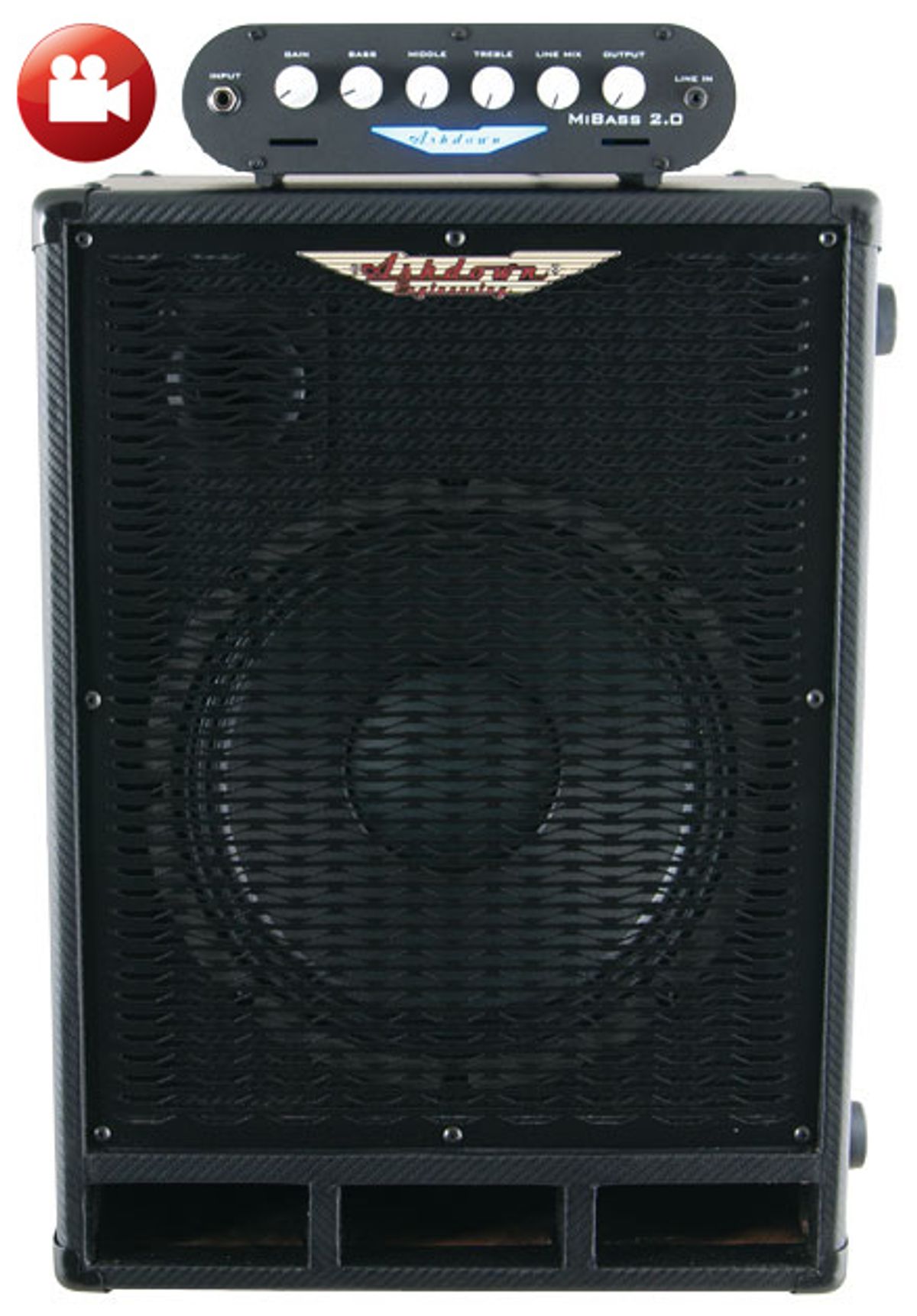A micro rig with beefy lows and stripped-down controls.
There are basically two schools of thought when it comes to bass amp components: Some players prefer amps with fully parametric EQ, an adjustable compressor, and more shelving options than an episode of This Old House. Others believe that fewer components preserve more of the original signal, and that only the bare essentials are needed for subtle tweaking.
The latter philosophy applies to Ashdown’s MiBass 2.0 amp and the Mi 12 cabinet—a sound reinforcement option for bass that exemplifies convenience and simplicity.
All of Mi
The MiBass 2.0 is a somewhat stripped-down version of Ashdown’s MiBass 220. Gone are the VU meter, tone-shaping buttons, and semi-parametric EQ. A simple interface provides only gain, bass, middle, treble, and output controls. One carryover from the previous model is a line-in with a mix/level control. Other features lurk at the back of the amp: a DI, a headphone jack, and a pair of 8-ohm speaker outs.
Ratings
Pros:
Great portability. Easy to use.
Cons:
4-ohm cabinets not an option. Louder club settings may be a challenge.
Tones:
Ease of Use:
Build/Design:
Value:
Street:
$499
Ashdown MiBass 2.0
ashdownmusic.com
I auditioned the MiBass 2 with Ashdown’s Mi 12, a front-ported 1x12 cabinet with a horn. Ashdown thoughtfully includes a heavy-duty handle, rubber feet, and black-tolex covering for this lightweight cab.
This 6 ½-pound amp and 35-pound cab score high on portability. The MiBass 2.0 easily fits in a gig bag pouch, and the Mi 12 balances quite nicely with its properly placed handle.
Tag Team Test
I tested the rig with a PRS Grainger 5 and a P-style Nash. I set the amp EQ flat and was met with a tone that was a touch shy in the low end, with noticeable brightness. There cabinet has no horn attenuator, but the amp’s EQ easily tamed the highs and thickened the low end. With the output knob set between 2 and 3 o’clock, the rig maintained a comfortable level for my practice room with no complaints from the neighbors.
The MiBass rig brought out the unique qualities of both the vintage-style Nash and the modern PRS. The rig’s inherent brightness catered to the active Grainger, and boosting the amp’s lows gave each note added booty. Impressively, the Mi 12 cab never seemed to struggle with beefy 5th-string low notes. For the Nash, a boost of the amp’s middle knob and a treble cut conveyed the warmth and fullness one would expect from a P-style bass.
Ashdown also provides the means to put some hair on your tones via gain-stage tube-emulation. Cranking the gain yielded gritty, overdriven tones that reminded me of a tube amp, but in a more back-friendly package.
Ratings
Pros:
Clean tone. Solid components. Easy to transport.
Cons:
No horn attenuator.
Tones:
Ease of Use:
Build/Design:
Value:
Street:
$339
Ashdown Mi 12 Cabinet
ashdownmusic.com
Curious how the rig would sound with an extension cab, I plugged an Epifani UL3112 into the second 8-ohm jack. (There is no 4-ohm jack.) As expected, the extra 12" driver added fullness, but I’d expected the rig to deliver a bit more volume with an RMS of 640.
Ashdown About Town
The amp and cab proved to be a great little practice rig, but how would it perform live? At a blues trio gig in a small club, my tone had a little difficulty keeping pace with drums and a Blues Junior-amplified guitar, though my DI signal managed to keep the bass tone present in the sound system.
While its stage volume didn’t quite fill the club, the rig functioned nicely at a piano trio restaurant gig. The notes from my German upright (outfitted with a Fishman Full Circle pickup) came through cleanly with strong acoustic character.
It also performed well at a studio jingle gig using a 1964 Fender Jazz bass. The rig delivered clean, slightly punchy tones to the board. All the engineer needed to add was a touch of compression.
The Verdict
Ashdown, no stranger to the micro-amp scene, delivers everything the company’s fans dig about the brand with the MiBass series. Combined, the MiBass 2.0 and Mi 12 cabinet are a simple, highly portable rig ideal for studio work and lower-volume gigs. Other comparably priced micro-amps may offer a more features, but the MiBass rig is great choice for bassists who don’t require lots of controls to tweak their tones.
Watch the review demo:



